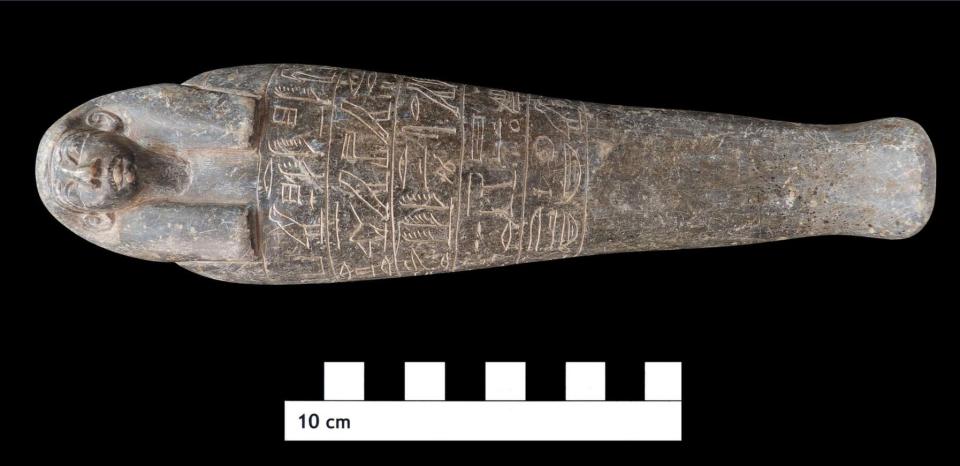It looks like you're using an Ad Blocker.
Please white-list or disable AboveTopSecret.com in your ad-blocking tool.
Thank you.
Some features of ATS will be disabled while you continue to use an ad-blocker.
14
share:
Stunned archaeologists discover 3,400-year-old ancient Egyptian
tomb containing more than a DOZEN mummies on an island in the Nile.
ASTONISHED archaeologists have uncovered an ancient tomb containing more than a dozen Egyptian mummies. The 3,400-year-old underground vault on Sai Island, northern Sudan, has multiple chambers and was discovered in 2015.

One of the ancient Egyptian caskets found in the tomb in northern Sudan
The vault was discovered in 2015 but was only cracked open this year But it wasn’t until this year that experts from AcrossBorders started to explore the mysterious tomb on the island, which is located beside the Nile River. The ancient Egyptians built settlements on the land, known then as Nubia, and developed a profitable gold mine. The remains found in the vault are thought to belong to a wealthy “gold master” and his family along with their funeral masks and rings which were made with the precious metal, reports Live Science.
Along with other Egyptian artefacts, the explorers found small stone sculptures called shabtis – which the ancient civilisation thought would become their servants in the afterlife. Some hieroglyphic inscriptions in the tomb suggest it was created for a main named Khnummose whose body was found next to the corpse of a woman which could have been his wife.
www.thesun.co.uk...
Sai Island one of the most important spot on the Nile, as various civilizations exploited it for it's gold, beginning with Ta-Seti an early kingdom pre dating those of upper Egypt proper, these folks were not exactly like the later Kush-ites that over ran them in about 2300 b.c ( different language group slightly different culture, they the Kushi-tes in turn got over ran by new Kingdom Egyptians, they centuries later took it back from Egypt..this back and forth would see the place of gold overran by the Turks of the near modern era..for as the golden rule goes ...he who have the gold makes the rules.
originally posted by: Spider879
Stunned archaeologists discover 3,400-year-old ancient Egyptian
tomb containing more than a DOZEN mummies on an island in the Nile.
ASTONISHED archaeologists have uncovered an ancient tomb containing more than a dozen Egyptian mummies. The 3,400-year-old underground vault on Sai Island, northern Sudan, has multiple chambers and was discovered in 2015.
One of the ancient Egyptian caskets found in the tomb in northern Sudan
The vault was discovered in 2015 but was only cracked open this year But it wasn’t until this year that experts from AcrossBorders started to explore the mysterious tomb on the island, which is located beside the Nile River. The ancient Egyptians built settlements on the land, known then as Nubia, and developed a profitable gold mine. The remains found in the vault are thought to belong to a wealthy “gold master” and his family along with their funeral masks and rings which were made with the precious metal, reports Live Science.
Along with other Egyptian artefacts, the explorers found small stone sculptures called shabtis – which the ancient civilisation thought would become their servants in the afterlife. Some hieroglyphic inscriptions in the tomb suggest it was created for a main named Khnummose whose body was found next to the corpse of a woman which could have been his wife.
www.thesun.co.uk...
An exciting discovery - but a TERRIBLE ARTICLE.
And that's not a casket - it's a ushabti.
A better article with a GORGEOUS photo of one of the coffins!
Another one - there's actually 8 mummies but 10 coffins
new topics
-
What Comes After January 20th
Mainstream News: 28 minutes ago -
Canada as a state .. how would it work?
General Chit Chat: 37 minutes ago -
Those stupid GRAVITE commercials
Rant: 1 hours ago -
Let's Buy Greenland
General Chit Chat: 2 hours ago -
Planned Civil War In Britain May Be Triggered Soon
Social Issues and Civil Unrest: 5 hours ago -
Claim: General Mark Milley Approved Heat and Sound Directed Energy Weapons During 2020 Riots
Whistle Blowers and Leaked Documents: 6 hours ago
14
